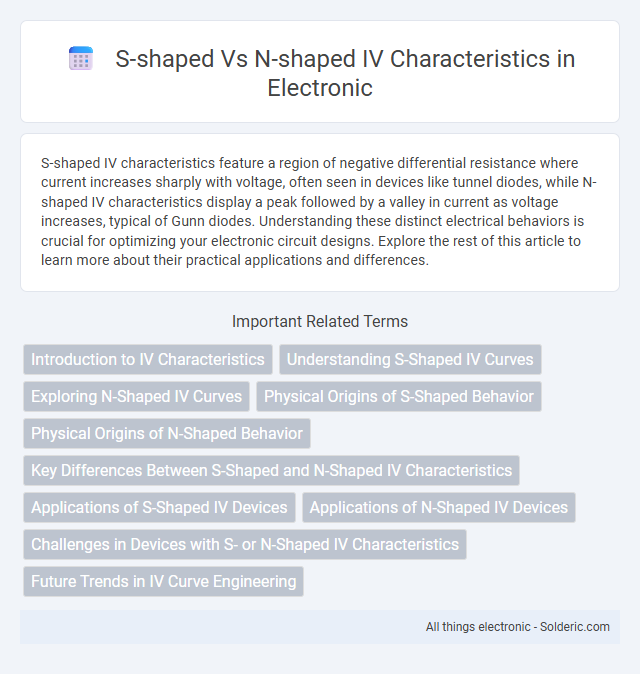S-shaped IV characteristics feature a region of negative differential resistance where current increases sharply with voltage, often seen in devices like tunnel diodes, while N-shaped IV characteristics display a peak followed by a valley in current as voltage increases, typical of Gunn diodes. Understanding these distinct electrical behaviors is crucial for optimizing your electronic circuit designs. Explore the rest of this article to learn more about their practical applications and differences.
Comparison Table
| Feature | S-Shaped IV Characteristics | N-Shaped IV Characteristics |
|---|---|---|
| Shape Description | Current (I) versus voltage (V) curve forms an "S" shape | Current (I) versus voltage (V) curve forms an "N" shape |
| Negative Differential Resistance (NDR) Region | Occurs at low voltage, current increases with voltage then decreases before rising again | Occurs at intermediate voltage, current increases, decreases, then increases sharply |
| Applications | Memristors, certain types of filamentary conduction devices, neuromorphic circuits | Gunn diodes, resonant tunneling diodes, high-frequency oscillators |
| Physical Mechanism | Controlled by filament formation and disruption or phase change dynamics | Due to intervalley electron transfer or quantum tunneling effects |
| Voltage Control | Voltage sweep reveals two stable current states at given voltages within NDR | Voltage sweep shows hysteresis with unstable region in the middle of the curve |
Introduction to IV Characteristics
IV characteristics describe the relationship between current (I) and voltage (V) in electronic components. S-shaped IV curves indicate regions of negative differential resistance where current increases with voltage before dropping sharply, common in devices like tunnel diodes. N-shaped IV characteristics feature a peak current followed by a decline and a rise, typical in Gunn diodes and IMPATT diodes, signifying complex charge transport mechanisms.
Understanding S-Shaped IV Curves
S-shaped IV curves exhibit a region of negative differential resistance where current decreases with increasing voltage, indicating complex charge transport or phase transitions in materials such as memristors or organic semiconductors. These curves are critical for identifying bistable states and resistive switching behavior, which are essential for memory devices and neuromorphic computing applications. Understanding the physical mechanisms causing S-shaped characteristics helps optimize device performance and predict stability under varying electrical stimuli.
Exploring N-Shaped IV Curves
N-shaped IV characteristics feature a region of negative differential resistance, where current decreases as voltage increases, creating a distinctive peak and valley in the curve. These curves are significant in devices like Gunn diodes and certain semiconductor oscillators, enabling high-frequency signal generation and amplification. Understanding N-shaped IV behavior helps optimize your electronic circuit design for stable operation under varying voltage conditions.
Physical Origins of S-Shaped Behavior
S-shaped IV characteristics arise from negative differential resistance linked to phenomena like impact ionization, carrier trapping, or thermal effects within semiconductor devices. These physical origins cause abrupt changes in carrier concentration or mobility, resulting in regions where an increase in voltage decreases current, forming the S-shaped curve. Understanding this behavior helps you optimize device performance in applications such as oscillators and memory elements.
Physical Origins of N-Shaped Behavior
N-shaped IV characteristics arise from regions of negative differential resistance caused by physical mechanisms such as charge carrier trapping, hot electron effects, or impact ionization, which lead to localized increases in current followed by abrupt drops. These phenomena occur in semiconductors and devices like Gunn diodes, where high electric fields induce electron domain formation and charge accumulation, resulting in the distinctive N-shaped curve. Understanding the physical origins of N-shaped behavior helps you optimize device performance and design circuits that leverage or mitigate these nonlinear effects.
Key Differences Between S-Shaped and N-Shaped IV Characteristics
S-shaped IV characteristics display a voltage range where the current decreases with increasing voltage, causing a region of negative differential resistance typically associated with devices like Gunn diodes. N-shaped IV characteristics exhibit a current peak followed by a decline and subsequent recovery, creating a distinct negative differential resistance region seen in devices such as tunnel diodes. The key difference lies in the shape of the voltage-current relationship curve and the underlying physical mechanisms, impacting device applications in oscillators and amplifiers.
Applications of S-Shaped IV Devices
S-shaped IV characteristics devices, such as thyristors and tunnel diodes, are extensively used in applications requiring controlled switching and bistable states, including power regulation and oscillators. Their ability to exhibit negative differential resistance supports high-frequency signal generation and memory storage elements in electronics. These devices play a critical role in voltage regulation, surge protection, and amplification circuits where precise current control is essential.
Applications of N-Shaped IV Devices
N-shaped IV characteristics are commonly found in devices such as tunnel diodes, Gunn diodes, and other negative differential resistance components used for high-frequency oscillators and amplifiers in microwave and terahertz technologies. These devices exploit the N-shaped curve's negative resistance region to enable fast switching, frequency generation, and signal modulation in radar and communication systems. Their unique electrical behavior is pivotal in designing resonant tunneling diodes and high-speed electronic circuits critical for advanced signal processing applications.
Challenges in Devices with S- or N-Shaped IV Characteristics
Devices exhibiting S-shaped IV characteristics often face challenges related to current instabilities and negative differential resistance, leading to potential oscillations and reliability issues in circuits. N-shaped IV characteristics typically pose difficulties in maintaining uniform voltage distribution and mitigating hot spot formation due to localized heating effects. Both S- and N-shaped behaviors complicate device modeling and require precise control of material properties and device architecture to ensure stable operation.
Future Trends in IV Curve Engineering
Future trends in IV curve engineering emphasize the development of hybrid S-shaped and N-shaped characteristics to optimize power electronic devices and improve energy efficiency in semiconductors. Advanced materials like perovskites and transition metal dichalcogenides are being explored to tailor IV responses, enabling precise control over threshold voltages and hysteresis effects. Your next-generation energy systems will benefit from enhanced device stability and increased operational lifespans driven by these innovative IV curve modifications.
S-shaped vs N-shaped IV characteristics Infographic

 solderic.com
solderic.com